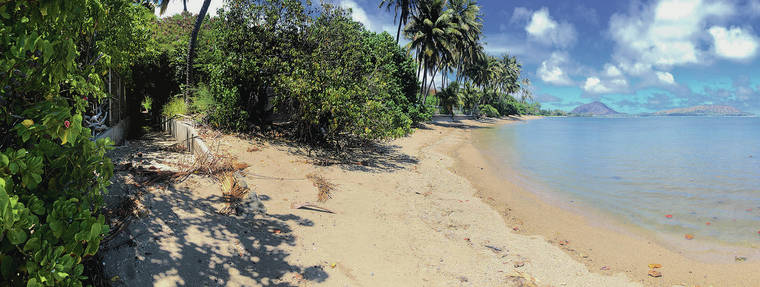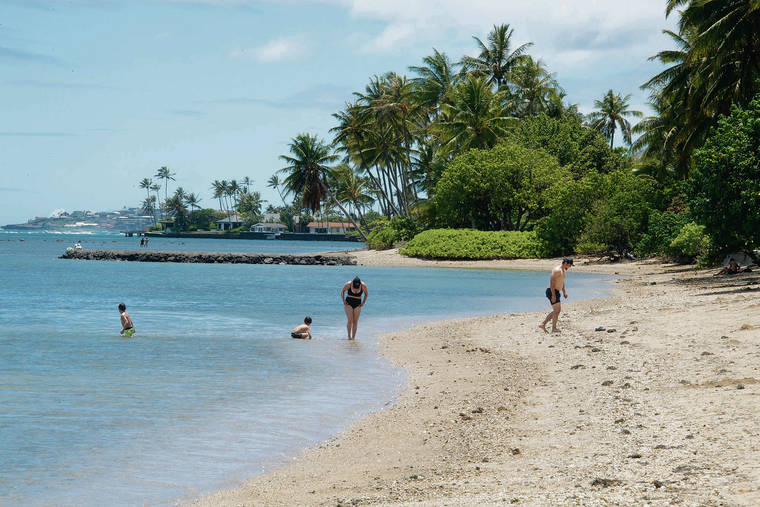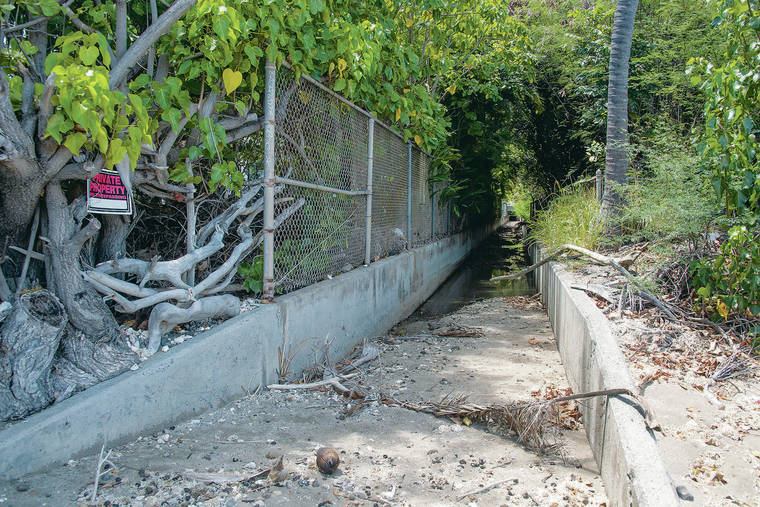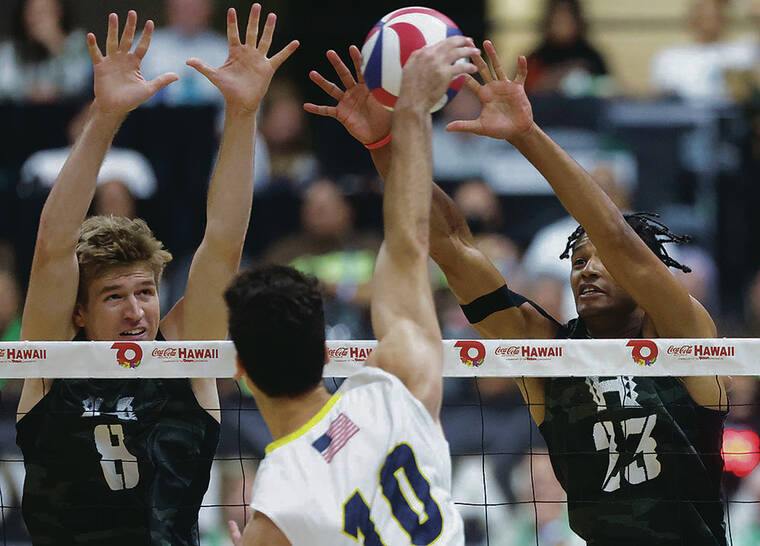How safe is the water in Hawaii you swim in?

CRAIG T. KOJIMA / CKOJIMA@STARADVERTISER.COM
Kawaikui Beach Park was one of the Oahu beaches that tested high for fecal indicator bacteria last year.

CRAIG T. KOJIMA / CKOJIMA@STARADVERTISER.COM
People enjoyed the water Wednesday at Kawaikui Beach Park in Aina Haina.

CRAIG T. KOJIMA / CKOJIMA@STARADVERTISER.COM
A culvert directs storm runoff into Kawaikui Beach Park in Aina Haina, contributing to pollution concerns. Elevated bacterial levels were found on three of the six occasions ocean water samples were taken at the beach last year.


Water at 55 of the 218 Hawaii beaches tested by the state Department of Health in 2020 exceeded the federal safety threshold for swimming on at least one day during the year, and 14 beaches were potentially unsafe on at least 25% of the days they were tested, according to a national report released this month.
In Honolulu County, beach water quality exceeded the standard for enterococcus, the fecal indicator bacteria, on 4% of the days testing was performed, according to the “Safe for Swimming?” report by the nonprofits Environmental Action and Frontier Group.
By comparison, among 258 beaches tested in California, 193 showed potentially unsafe levels on at least one day, and 42 beaches on at least 25% of the days they were tested. In Los Angeles County, beach water exceeded the threshold on 16% of testing days.
While Oahu’s 4% average may not seem like much, frequency of testing plays a part, said John Rumpler, director of Environmental Action research and policy and coauthor of the report, which analyzed data collected from states by the U.S. Environmental Protection Agency under the federal Beach Act.
“Some beaches are tested more than others,” Rumpler said in a phone interview, “so there could be high bacterial levels at beaches on nontesting days that go undetected, and swimmers could be unknowingly exposed to pathogens in fecal matter,” which can cause illnesses such as gastroenteritis.
For instance, California’s top 10 high-bacteria beaches were tested from 162 to 307 days, while Hawaii’s top 10 polluted beaches were tested from five to 58 days.
Don't miss out on what's happening!
Stay in touch with breaking news, as it happens, conveniently in your email inbox. It's FREE!
On Kauai, where the water off 33 beaches was tested, the average beach was potentially unsafe for swimming on 5% of the days that sampling took place, a higher percentage than any other county in the state. The percentage was 4% in Hawaii County, where testing took place at 34 beaches; 4% for Oahu, where 110 beaches were tested; and 2% in Maui County, where 41 beaches were tested.
Muddying matters somewhat for Hawaii beachgoers this year is a procedural change that reduces the number of bacterial advisories posted and can delay their posting for a day or two.
Since December, the Hawaii Health Department’s Clean Water Branch has been issuing notifications after a beach water sample exceeds the EPA’s Beach Action Value of 130 enterococci/100 mL “and informs the public that we are re-testing the waters,” Myron Honda, branch administrator, said in an email.
Previously, the branch issued advisories and posted no-swimming signs on beaches where tests showed high bacteria levels.
“No signs are posted on the affected beaches during a Notification, but emails are sent out to our subscribers” and the notice is posted at eha-cloud.doh.hawaii.gov/cwb Opens in a new tab, Honda said, urging people to visit the website and subscribe.
If the follow-up sample exceeds 130/100 mL, or if it’s Friday or the day before a holiday, “an Advisory is issued so we can post signs on any affected beach, since we cannot re-test on weekends or holidays,” he added, noting followup samples are collected on each working day until levels drop.
“After reviewing the data from more than 8,200 samples between 2017 (the start of the beach program) and June 2019, we found that about 92% of the time, the follow-up samples did not exceed the BAV (and) the beach advisories were not warranted,” Honda said, noting it takes 24 hours to get test results from the lab.
Hawaii divides beaches into three tiers: On Oahu, Tier 1 contains 23 beaches, which are tested once a week; Tier 2 has 21 beaches, tested less frequently; and Tier 3’s approximately 100 beaches are tested once or twice a year.
Last year, Waikiki’s Kahanamoku Beach and the beach fronting the Royal Hawaiian Hotel and Moana Surfrider, Kawaikui Beach Park in Aina Haina and Laenani Park in Kaneohe had Oahu’s highest percentage of testing days with bacterial exceedances.
Kahanamoku Beach was tested on 48 days, with potentially unsafe contamination found on four days for an 8% rate. The Royal Hawaiian-Moana Beach was tested 44 days, with three days of elevated bacteria for 7%; Laenani Park was tested on five days, with three high results for a 60% rate; and Kawaikui Beach was tested on six days, with elevated bacterial levels found on three days for a 50% rate.
The Clean Water Branch’s most recent notifications on Oahu were for Kahanamoku Beach, issued June 29 with 359 bacteria per 100 mL and canceled July 2, and Waianae’s Pokai Bay, issued June 28, with 137 per 100 mL and canceled June 30.
Supplementing the state’s program, Surfrider Foundation provides biweekly beach water testing by volunteers. Oahu Chapter volunteers collect samples and take them to the University of Hawaii at Manoa’s Kewalo Marine Laboratory to be tested.
Test results for the beaches Surfrider monitors can be viewed at its Blue Water Task Force website, bwtf.surfrider.org/report/44/859 Opens in a new tab.
Among Surfrider’s most recent tests, on June 27 and July 11, beaches at Black Point, Ala Moana Bowls, Point Panic Stairs, Puaena Point, Pupukea tidepools, Waimanalo and Wailupe Stream had low bacteria levels.
On July 11, Kuliouou Stream had medium bacteria of 86/100mL, but had high bacteria on every other test this year, ranging as high as 15,531/100 mL on April 4.
Wailupe Stream, which outflows near Kawaikui Beach, has had low bacteria in tests since May 16, but had high bacteria April 4, and 3,255/100 mL on Feb. 2.
A June 13 sample at Chocolates in Haleiwa had 1,918/100mL, and a July 11 sample at Hakipuu Boat Ramp in Kaneohe had 327/100mL.
“One could argue the Hawaii numbers are artificially low,” Rumpler said, because the state also does not sample or test at streams, or when there is brown water at beaches following heavy rainfall or sewage spills.
“We do not test when we issue a brown water advisory because we have data to show that it is highly likely that the Beach Action Value will be exceeded whenever there is surface runoff,” Honda said.
Instead, the state posts no-swimming signs where brown water is observed and closes beaches after sewage spills, Honda said, noting enterococcus is present in Hawaii’s forest soils as well as in human and animal sewage.
“Also, we can issue the brown water advisory immediately rather than waiting 24 hours for results,” he added.
The study, Rumpler said, underscored the urgent need to reduce pollution running into the ocean.
On July 8, as part of the general infrastructure bill being shaped by Congress, the U.S. House of Representatives approved a package of $40 billion for state clean water funds, to include investment in sewage treatment plants and wetlands that absorb runoff.
Rumpler urged citizens to ask their senators to approve the package in turn.
To read the study and learn more about the legislation, go to environment america.org Opens in a new tab.





